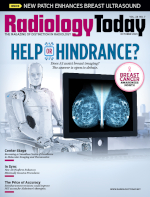 MRI Monitor: Striking Copper
MRI Monitor: Striking Copper
By Keith Loria
Radiology Today
Vol. 24 No. 7 P. 29
A group of researchers at the Universities of Birmingham in England and St Andrews in Scotland have discovered a revolutionary use for copper in MRI contrast agent design, which could eventually lead to better images and help physicians diagnose patients’ conditions more easily and safely.
During a study, the group unearthed a novel copper protein binding site, which does not occur in nature, and concluded it has real potential for use in MRI contrast agents used to improve the visibility of internal body structures in scans. The researchers, along with Diamond Light Source, published their findings in PNAS after creating a highly elusive abiological copper site bound to oxygen donor atoms within a protein scaffold. The discovery came about by a happy accident.
“We were developing a new-to-biology copper site and were keen to explore its properties and chemistry,” says Anna Peacock, MChem, PhD, a reader in bioinorganic chemistry at the University of Birmingham, who cowrote a paper on the research. “It’s really rather lucky that we explored its MRI properties, and we only really did so as we already have experience of looking at the MRI of gadolinium complexes.”
She explains that, previously, copper wasn’t thought to be a viable solution, but that theory proved was shown to be incorrect as the binding site was proven to display extremely promising contrast agent capabilities, with relaxivities equal and superior to the gadolinium agents used routinely in clinical MRI.
“Copper on its own doesn’t show high relaxivity—a measure of MRI contrast agent efficiency,” Peacock says. “However, when bound to our ligand, a coiled coil, it does. We are now investigating the mechanism by which this works.”
High Hopes
The benefits of such a discovery are myriad. Most importantly, the copper coil is capable of relaxivity higher than clinical agents. In theory, a higher relaxivity complex can either be administered in smaller amounts to achieve the same level of contrast as lower relaxivity clinical agents or can be administered at the same level and achieve greater contrast. This allows doctors to diagnose conditions in an easier and safer way.
“The potential to use copper as the paramagnetic metal in MRI contrast agents means that many new metal complexes can, in theory, be investigated for potential use,” Peacock says.
In MRI scanners, sections of the body are exposed to a strong magnetic field, causing hydrogen nuclei of water in tissues to be polarized in the direction of the magnetic field. The magnitude of the spin polarization detected is used to form the MR image but decays with a characteristic time constant known as the T1 relaxation time.
Water protons in different tissues have different T1 values, which is one of the main sources of contrast in MR images. A contrast agent usually shortens, but in some instances, increases the value of T1 of nearby water protons, altering contrast in the image and improving the visibility of internal body structures, with the most used compounds being gadolinium-based contrast agents. That’s why this finding is valuable, as it shows real potential for use in contrast agents and challenges existing dogma that copper is unsuitable for use in MRI.
The researchers noted that copper can also be used in PET scans through biomodal imaging, which means the same agent can be administered and imaged using two different techniques.
“Metal sites that are not part of the repertoire of biology are vital in providing protein designers with an expanded toolbox of chemistries they can use to design new functional systems, such as the promising imaging capabilities reported here,” Peacock says. “This opens up applications beyond what biology is currently capable of and showcases some of the advantages of using simple miniature protein scaffolds as a means with which we can engineer new, and maybe currently unknown, metal-binding sites.”
Still, Peacock warns that the work is very much at an early stage and entirely in vitro. In vivo work will be the next step, and the results will be closely followed by many in the industry to see whether similar results occur. “We are very much at first stage of development—TRL level 1,” she says.
“We are now keen to study how these systems work and, in turn, optimize their performance.”
Therefore, it will be some time before original equipment manufacturers start utilizing copper in their equipment.
“Given our findings that copper complexes are capable of high relaxivity, I do wonder if future MRI contrast agents may, in fact, be based on copper instead of gadolinium,” Peacock says.
She explains that gadolinium (in the form of Gd3+) is often used as a contrast agent, but there are environmental and patient safety concerns that make exploration of new contrast agents an important and active research area.
“Given the concerns associated with the deposition of gadolinium in the tissues of patients—including the brain—and gadolinium- based contrast agents’ recognized role as environmental contaminants of water sources, the use of an essential element such as copper would be attractive,” she says.
— Keith Loria is a freelance writer based in Oakton, Virginia. He is a frequent contributor to Radiology Today.
